Ed Gorman's Blog, page 107
December 13, 2013
Stark House Charles Williams duo + the great Ray Banks
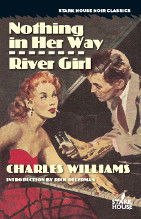
$19.95 Nothing in Her Way / River Girl978-1-933586-63-2Nothing in Her Way presents a convoluted story of two con artists, while River Girl is a classic backwoods thriller about a man who falls for the wrong woman. Both of these novels were originally published in the early 1950's by Gold Medal Books. Author Max Allan Collins calls Williams the "the best kept secret in noir fiction." Our edition includes a new introduction by Rick Ollerman and is scheduled for December 2013.
Ed here: If you've never read Charles Williams then you've never read American noir's most important neglected writer. ---------------Ed here: You can find the entire article by Ray Banks at the very cool Mysterious Press e books site.http://mysteriouspress.com/blog/five-... Noir Lessons from Charles Williams by Ray BanksBill Crider once said that "there's no such thing as a bad Charles Williams novel". Even though I've yet to finish Williams' 22-strong bibliography, I'm inclined to agree. More than that, I'd argue that Charles Williams was one of the best (if not the best), and certainly the most consistent, of the Gold Medal boys.But while the other heroes of the paperback, like Jim Thompson or David Goodis, have been reappraised, republished and canonised, Williams remains sorely underrated and—until now—largely out of print. It's a pity, because out of all of the 50s noir novelists, Charles Williams should be a major influence on modern noir, a subgenre which can sometimes feel choked with cinematic cliché and sophomore nihilism. Williams has plenty to teach the aspiring noir novelist, and even more to offer those of us who may feel that noir has reached the limits of self-parody. And so here, for your delectation and amazement, are five noir lessons to be learned from the work of Charles Williams.
The femme is more important than the fatale.You'd think that I wouldn't have to mention something like this in the second decade of the 21st Century, but here we are and so it goes: Charles Williams is one of the few noir novelists of any generation and either gender to write complex, engaging female characters. Indeed, there's an argument to be made that Williams was more interested in his women than his men, that his men are actually largely defined by their relationships with the women, and that the women are the ones who end up triumphant because they possess a self-awareness, intelligence and crippled humanity that the men can only begin to know in their final, doomed moments.
Published on December 13, 2013 15:04
December 12, 2013
Pro-File: Vicki Hendricks and her new book FUR PEOPLE

Print:http://www.amazon.com/Fur-People-Vick...
Kindle:http://www.amazon.com/s/ref=nb_sb_nos...+
Audible:http://www.amazon.com/s?ie=UTF8&f...
“A fierce and fearless talent”—Dennis Lehane, author of Mystic River
“It’s so rare to encounter the real thing these days that when you do, as in Hendricks’ sledgehammer of a first novel [Miami Purity], the effect is all the more intense.”—Booklist
“Hendricks may be the least commercial but most literary of Florida crime writers. . . . Her stories evoke Flannery O’Connor and Erskine Caldwell.”—Booklist.
“This Vicki Hendricks is one wild dame. She goes places the rest of us have never been, don’t even know the way to; and she comes back with stories that prove that everyone’s lonely, everyone’s trying, and everyone’s human. Even when they’re not.” –S.J. Rosan, author of The Shanghai Moon.
Vicki Hendricks is the author of noir novels Miami Purity, Iguana Love, Voluntary Madness, Sky Blues, and Cruel Poetry, the latter a finalist for an Edgar Award in 2008. Her collections are Florida Gothic Stories and Dangerous Sex: Three Stories. Vicki lives in Hollywood, Florida, and teaches writing at Broward College. Her plots and settings reflect participation in adventure sports, such as skydiving and scuba, and knowledge of the Florida environment. Love of animals, apparent in her earlier novels, comes to the forefront in Fur People. Find her at www.vickihendricks.com
Can you give us a sense of what you’re working on now? I just finished Fur People so that’s the one I can talk about. I’m generally known for my erotic crime or noir novels, but Fur People belongs in the animal lit genre—if that’s considered a genre. It certainly deserves to be. Very little sex and no murder in this one. As usual, my main character is obsessed, but this time with passion for animals. I know what my old fans are thinking—bestiality—but no, not even a hint! Sunny Lytle is a young woman caring for many dogs and cats, and a couple rabbits and ferrets, and hoping to eventually open her own animal shelter. She’s a dreamer, sacrificing everything, struggling. She gets evicted from her apartment and moves back to the woods near her hometown in central Florida. Sunny hopes to rekindle the relationship with her high school boyfriend, avoid her drunk father, and provide for the growing number of animals, by then living with her in a school bus. She develops telepathy with the animals, which wreaks additional havoc in her life, and gains a buddy, Buck, a homeless man. He’s a pretty good guy for her, but is bedeviled by harmful rays from the sky, so even though there aren’t any murders in the book, there’s plenty of trouble.
What is the greatest pleasure of a writing career?
I would have to say the friendships I’ve had with writers over the years, the writing life altogether. Writers are the kindest people and lots of fun. They’re always willing to share their expertise and their time, and there’s little competition among them, certainly none of a mean-spirited nature that I’ve ever seen. I have to cite Top Suspense Group as a great example. Busy people, always, yet willing to help each other out—to help me out—in every way possible. Of course, I love books, and I love that I’ve written some.
The greatest displeasure?
The writing process itself. I could live without that. I hear people saying how much they enjoy getting words down on paper or up on the screen, but to me, it’s pure torture—I’m torturing myself right now, although I hope it sounds like I’m enjoying the heck out of talking about myself. And this isn’t anywhere nearly as bad as writing fiction—mainly my back hurts from sitting in the chair too long. I can only think that people who enjoy writing must have hypergraphia, like Stephen King supposedly does. I wish it was contagious. I sat next to him at dinner once—no luck, but it was fun. I guess, in part, though, it’s the tedious, frightening, prolonged agony that makes you feel so good by comparison when the writing is done. I’d still rather have magic.Nowadays, to add to the displeasure, is the need to get your book out to the public. If Internet exposure had been required when I wrote Miami Purity, I would have given up right then. I’m fairly incompetent at quick response, technology, and spotting publicity opportunities. My skill is to wrap myself up in characters and chew around on their words until things happen. One sentence leads to another, and then I double back and start over, and over, and over. Then I really just want to sit back and hope people like it and tell their friends. This is not the way it works right now, and I can’t see it changing back in the near future.
Advice to the publishing world?
Relax. Everyone: sit down, grab a nice cat, place it on your lap, and pet gently. A small dog will work just as well, and one of each would be really groovy. Other than that, I don’t have a clue about that business, especially now.
Are there any forgotten writers you’d like to see in print again?
Harry Crews, one of my number one favorite writers, recently deceased, has no novels available on Kindle, and several are unobtainable for less than $300. Back in the late 80’s when I discovered his work, some were already collectibles in that price range, so I never read a few of them. I don’t know who has the rights, but I wish somebody would at least put them up as ebooks. I don’t know why there’s never been a film of any of his novels either. He’s always had a passionate following, and his stuff is gritty and wild, perfect for film.
Tell us about selling your first novel.
It was a fairy tale, a dream that I never dreamed. Miami Purity was my thesis for an M.F.A. at Florida International University, and I was just happy to finish it and get a raise at Broward College for completing a terminal degree. Since I knew it was the thing to do, I sent the novel out a few times, and kept working on it for about two years, and through the writing program, I got the name of an agent who took it to Sonny Mehta at Knopf. He loved it instantly and I actually got a call when I was sitting in a fiction workshop at a writers conference. It was late afternoon on a Friday and the agent left a message, which someone brought to me in the middle of the class. I thought it was a joke, but everybody started congratulating me and buying me drinks, and I celebrated while the time was right. Sure enough, come Monday, the fantasy became true.Mehta published it under Pantheon, and the company treated me like a queen. Those were the good old days with wonderful fringe benefits. Editors, publicists, cover artists, assistants of all kinds—in the U.S. and the U.K.—seemed available for my bidding. Random House treated me to the most luxurious book tours I could imagine. In New York they took me out to dinners and a Tom Stoppard play that I wanted to see. For my bookstore reading, I’m certain the whole staff was obligated to attend. On the West Coast, I was partnered up with James Ellroy, for a sort of apprenticeship, so I reaped the pleasure of having a huge audience everywhere I went. Also, an advance like I received back then is almost non-existent now, and the traditional book tour is all but dead, so I consider myself supremely lucky in many, many ways.
Published on December 12, 2013 10:01
December 11, 2013
Marcia Muller writing about the new Marcia muller Bill Pronzini novel THE SPOOKS LIGHTS AFFAIR

Marcia Muller
Imagine a foggy night in 1895 San Francisco. A formally dressed young woman flees from a lavish party hosted by the mayor, Sabina Carpenter in close pursuit across spacious grounds and up onto a parapet overlooking the sea. In her flowing white gown the girl climbs onto a low wall, stands like a spectral image in the fog, and then presumably leaps to hear death down the sheer cliff beyond. Presumably, because her body is nowhere to be found on the deserted highway below.
Meanwhile, John Quincannon, Sabina's partner in Carpenter and Quincannon, Professional Detective Services, is on the trail of a bandit who robbed the Wells, Fargo office of $35,000. A tip leads him to a ramshackle cabin atop Telegraph Hill, where he discovers the murdered body of a man who may or may not be thief -- and no sign of the missing money.
So begins THE SPOOK LIGHTS AFFAIR, the second entry in our collaborative series about this intrepid duo. What ensues is an increasingly complicated mix that leads, among other places, to a deserted estate the Burlingame hills and to Carville-by-the-Sea, a ramshackle collection of old trolley cars scattered among the sand dunes on the western edge of S.F., where another case of mysterious m"spook lights" is taking place. Working separately and together, they find that their investigations intersect. And they receive unexpected help in solving them from the shrewd "crackbrain" (introduced in the previous novel, THE UGHOUSE AFFAIR) who believes himself to be Sherlock Holmes.
Background note: Sabina and Quincannon were originally created by Bill for his 1985 novel, QUINCANNON. At that time John was an agent with the San Francisco office of the U.S. Secret Service, and Denver-based Sabina was one of the Pinkerton Detective Agency's women operatives known as "Pink Roses," and both were working undercover in a small mining town in Idaho. Later John quit the Service to open his own detective agency, and convinced her to move to S.F. and join him as an equal partner. Their various and often gender-based skills allow them to work well together. The only problem that lies between them is John's infatuation with Sabina and her determination to keep the relationship on a strictly professional basis. But surely, he wistfully thinks, the day will come when she will succumb to his charms. Is he right or wrong? Stay tuned....
Teaser: We've just delivered the third novel in the series, THE BODY SNATCHERS AFFAIR. In this one, the wife of an opium-addicted lawyer enmeshes Quincannon in intrigue in S.F.'s Chinatown involving murder and the theft of the embalmedcorpse of a recently deceased tong leader, evidently by a rival tong. Sabina, meanwhile, in addition to assisting John on the Chinatown business, finds herself investigating two different, unrelated cases -- another body-snatching, this one of the remains of a rich Nob Hill businessman from the family crypt,and a disturbing mystery rooted in the past of the socialite stockbroker she's currently dating. Also involved yet again: the enigmatic gent who calls himself S. Holmes.
Published on December 11, 2013 12:11
December 10, 2013
an oldie that got me in a lotta trouble--john ford
SUNDAY, NOVEMBER 26, 2006
What he basically said was that the only really good film Ford ever did was The Searchers and that the rest of them--paerticularly those he's celebrated for--are mawkish, formulaic, ham-handed melodramas set in a west that never existed. He does allow that at least a few of the later films such as Cheyenne Autumn do try to get away from his claptrap about the Army in the west. Read a military journal sometime if you want to see how full of beans Ford was.
God, I'm glad Thomson wrote that. I've always felt the same way about Ford. I agree especially with what Thomspon said about My Darling Clementine. What a piece of bullshit, a drunken Mick's mauldin tribute to a "code" that is laughable. Give me Deadwood any day.
As Thomson suggests, look at the directors who worked at giving us a more realistic portrair of the west--Anthony Mann certainly and later Sam Peckinpah. Gunsmoke at its best was far truer to the reality of the frontier than Ford ever was.
This is beginning to sound personal. And cranky. I apologize for the tone. -Ford was an important director in the development of a certain type of stagey and paper-thin melodrama. He was both popular and influential. I'm not taking anything away from his success. But even as a kid I thought all the John Wayne stuff was a crock. I knew a lot of tough guys growing up and not a one of them remotely resembled Duke because Duke was another of Ford's fantasies. I had relatives die in WW11, Korea and Nam and never saw a soldier yet who spoke the Duke comic-book crapola about the glories of war and the wonders of machismo.
Ford and an array of other directors spent decades turning a serious part of American history into racist lies for the masses. And I don't mean this in any PC way. Dances With Wolves was just as much a left-wing distortion of Native American history as Ford's was a right-wing distortion.
I'm just glad Thomson had the nerve to speak up.
Aren't you sorry you asked?
Published on December 10, 2013 13:56
December 9, 2013
one of my top ten noirs from TCM (I an't find the author name)
TCM Pick for August: Film Noir
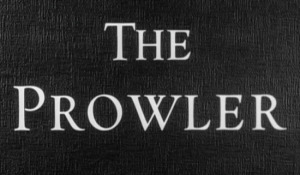 Best thing about selecting The Prowler as my TCM film noir pick of the month? It nudged me into replacing my barely watchable VHS copy with a spanking brand-new DVD! Second best? It gave me an excuse to give a much-appreciated re-watch to this unique and first-rate example of the film noir era. Released in 1951 and starring Van Heflin and Evelyn Keyes, The Prowler airs August 6th, part of the Van Heflin spotlight during TCM’s month-long Summer Under the Stars extravaganza. (For some other excellent Heflin noir performances, I strongly urge you to catch Possessed and Act of Violence, as well as Johnny Eager, for which Heflin deservedly won an Academy Award. But I digress.)The plot:Susan Gilvray (Evelyn Keyes), lonely wife of a nighttime radio personality, calls the cops after she spies a prowler outside of her window. One of the officers who answers the call is (love this name!) Webb Garwood (Van Heflin), who makes no secret of his instant attraction to the distressed damsel. Webb’s interest is piqued when he learns that said damsel just happens to be from the same area in Indiana from which he hails. (It’s a small world after all!) And the fact that she’s “happily” married doesn’t seem to matter – to either of them, as it turns out. But when Webb comes up with a foolproof plan to snag the girl of his dreams, it turns out to be a nightmare for all concerned – and that’s just the first half of the movie!My favorite scene begins . . .
Best thing about selecting The Prowler as my TCM film noir pick of the month? It nudged me into replacing my barely watchable VHS copy with a spanking brand-new DVD! Second best? It gave me an excuse to give a much-appreciated re-watch to this unique and first-rate example of the film noir era. Released in 1951 and starring Van Heflin and Evelyn Keyes, The Prowler airs August 6th, part of the Van Heflin spotlight during TCM’s month-long Summer Under the Stars extravaganza. (For some other excellent Heflin noir performances, I strongly urge you to catch Possessed and Act of Violence, as well as Johnny Eager, for which Heflin deservedly won an Academy Award. But I digress.)The plot:Susan Gilvray (Evelyn Keyes), lonely wife of a nighttime radio personality, calls the cops after she spies a prowler outside of her window. One of the officers who answers the call is (love this name!) Webb Garwood (Van Heflin), who makes no secret of his instant attraction to the distressed damsel. Webb’s interest is piqued when he learns that said damsel just happens to be from the same area in Indiana from which he hails. (It’s a small world after all!) And the fact that she’s “happily” married doesn’t seem to matter – to either of them, as it turns out. But when Webb comes up with a foolproof plan to snag the girl of his dreams, it turns out to be a nightmare for all concerned – and that’s just the first half of the movie!My favorite scene begins . . .
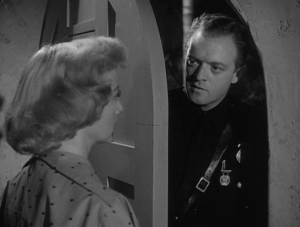
Favorite scene:It’s brief, but it’s one of the steamiest scenes I can think of in all of film noir. After being rebuffed by Susan during a previous visit, Webb returns to her home to apologize for his brutish behavior. With little opposition, Webb is soon talking Susan into sharing a dance, during which he offers up a hypothetical, “what if” supposition, founded on the premise that they could have met at a school dance years earlier. Holding Susan in an embrace that is equally gentle, firm, and passion-filled, Webb murmurs in her ear what could have happened: “I’d have asked you your name and you’d have told me. I’d have told you how swell you danced. How pretty you were.” Before long, Webb is slowly, deliberately moving in for a kiss, and Susan is begging him – oh, so halfheartedly – to stop. And when the camera moves from the couple to the radio across the room – well, need I say more?Favorite quote:Offering up two faves again this month:“If I was happily married to a girl like you, I wouldn’t leave you alone nights.” Webb Garwood (Van Heflin)“You’re a real cop, aren’t you? You want everything free.” Susan Gilvray (Evelyn Keyes)
for the rest go here:http://www.blogger.com/blogger.g?blog...
Published on December 09, 2013 15:08
December 8, 2013
Win the new #DiagnosisMurder Complete Series DVD boxed set from the show's writer/producer @LeeGoldberg .
Win the new #DiagnosisMurder Complete Series DVD boxed set from the show's writer/producer @LeeGoldberg . No purchase necessary to win! http://www.leegoldberg.com/diagnosis-murder-christmas-giveaway/
Published on December 08, 2013 08:10
December 7, 2013
Sam Peckinpah - a different take
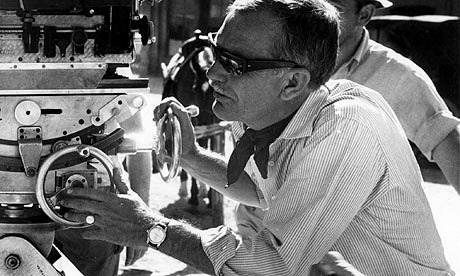
Inside the head of Sam Peckinpah
So the great director's films are about violence? Not really. Are they about honour? Hardly. In fact, says Rick Moody, Sam Peckinpah offered us realism - albeit of a very particular kind Rick Moody The Guardian, Thursday 8 January 2009
'Undisputed poet of alcoholic cinema' ... Sam Peckinpah on the set of The Wild Bunch. Photograph: Ronald Grant Archive"Now, most funeral orations, Lord, lie about a man," - so says David Warner, in his memorable turn as Joshua, the fraudulent preacher in Sam Peckinpah's The Ballad of Cable Hogue, from 1970. The same can be said of most film criticism - that it dissimulates or exaggerates about the film, about the director, about the movement, about the art. So let's aspire in this revisionist essay on Peckinpah to tell the truth. Although it's worth noting that when you believe what characters say in a Peckinpah film, you play right into the director's malevolent hands.. Nevertheless, the first point that must be made, here in the 21st century, is that Peckinpah's films are not terribly violent. That's how he made his reputation: as "Bloody Sam", the man who never met a bucket of theatrical blood he wasn't willing to splash around, and who always made certain you knew when the blood was about to flow, by means of slow motion. Still, by today's standards, the better part of the Peckinpah canon is not terribly violent - not when judged against today's rivers of gore. There are, in Peckinpah, no fountaining bodies, no bits of brain tissue splattered about. Anything released in the last 20 years is quite a bit more repellent. Seen any of those Saw movies?Ride the High Country is a good place to start for the uninitiated. Released in 1962, it scarcely departs from the western as we understand it. There's the good guy, Steve Judd, and the bad guy, Gil Westrum, and they behave according to type for the first reel, at least until they get into the business of saving a young, impetuous romantic (the very first film role of Mariette Hartley) from her up-country fiance. Then the good guys and bad guys get curiously admixed, till it is hard to tell which is which. Indeed, Hartley's impetuous tomboy and Randolph Scott's old cowpoke have, toward the end, an exchange on the ubiquity of gray areas between right and wrong.This exchange could serve as a template for the morality of the entire Peckinpah oeuvre. Still, the threatened gang rape in High Country happens mainly by implication, and there is little here of Peckinpah, master of the high-noon showdown. Even in the midst of the climactic shootout, the camaraderie between the "bad" Westrum and the "good" Scott, as they pick off a posse of far worse mountain men, is anything but removed from the western genre. The shootout involves a lot of grimacing, and there is ample time, despite perforations, for Scott's last pronouncements. After which the orchestra swells!for the rest go here:
http://www.theguardian.com/film/2009/...
Published on December 07, 2013 14:15
December 5, 2013
Steve McQueen's really bad decision; The Career of John Sturges
THOSE GLORIOUS OLD MOVIE PHOTOS: JOHN STURGES AND STEVE MCQUEEN ON THE SET OF "LE MANS" (1971)
 (Thanks to Cinema Retro contributing writer Steve Saragossi for sharing this rare photo).
(Thanks to Cinema Retro contributing writer Steve Saragossi for sharing this rare photo). From Cinema Retro
The feud between John Sturges and McQueen was tragic...he had made McQueen a star in Magnificent Seven and The Great Escape. However, McQueen's long-delayed plans to bring a racing movie to the screen culminated in the ill-conceived Le Mans. The two old friends feuded over the film's concept. After Sturges quit the project, "B" movie director Lee H. Katzen took over. The film was one of the few outright bombs of McQueen's career, consisting mostly of footage of speeding cars and virtually no plot. (Thanks to Cinema Retro contributing writer Steve Saragossi for sharing this rare photo).
From Suspense Movies.com
The Career of John Sturges by Steve Badger
Perhaps due to the blue-collar workmanship of his films, no director ever made as many enduringly popular movies as John Sturges while being largely forgotten himself. Rarely has an artist ever made such popular body of work while making himself as anonymous as possible. No "look at me, I'm a director" touches. The movies occur. Stories of beauty and substance are told well. Just for that accomplishment alone, John Sturges deserves to be remembered as one of America's greatest filmmakers. The Great Escape (1963). Simply THE World War II prison camp movie, which says a lot. Several stars Sturges' uses time and again are here, including Steve McQueen. First Sturges made McQueen a star. Then he made him a superstar. Finally, in The Great Escape, Sturges made McQueen a film icon. Based on the true story of the largest escape from a German prison camp during the war, Sturges conveys the triumph of the human spirit in the meticulous escape planning, the ingenious details, the courageous escapees, the ultimate tragedy -- and even the disillusionment of the non-Nazi Germans. It has equals, but you can't make a better movie.
The Magnificent Seven (1960). While this is a remake of Kurosawa's Seven Samurai and is set in Mexico, in many ways it is the archetype American film. The near-perfect mix of story, music, personalities, pacing and visuals hits on every cylinder. When the peasants offer gunman-for-hire Yul Brynner the combined fortune of everything in the village, Brynner replies: "I've been offered a lot when I work... but never everything." Likewise, this film has everything. While some elements may seem cliched today, this is the film that made those cliches. James Coburn and Robert Vaughn became movie stars, and Steve McQueen became a superstar: "I never rode shotgun on a hearse before."
for the rest go here:
http://www.suspense-movies.com/direct...
Published on December 05, 2013 15:27
December 4, 2013
The Falcon and The Co-Eds
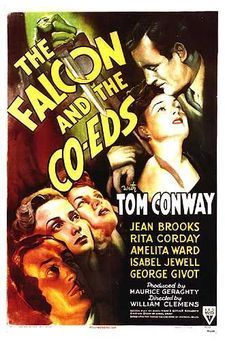
Ed here: When I got back from Mayo this spring my friend Max Allan Collins had a great gift waiting for me--a DVD of Falcon movies. Here's an fine review of one of the best of them from The Stalking Moon. Go here for the whole article.
http://thestalkingmoon.weebly.com/5/p...
More moody and atmospheric than the series' norm, The Falcon and the Co-Eds mixes a pinch of Daphne Du Maurier-esque melodrama into the formula, as Lawrence finds himself posing as an insurance investigator looking into the suspicious death of a popular male teacher at the all-girls Bluecliff Academy. The local coroner's verdict was death by suicide, but the Falcon soon susses out that the man was deliberately poisoned. Several members of the staff at the school, and even a few students, find themselves on the suspect list, including the sultry, hard-boiled Ms. Gaines (Jean Brooks); her sometime paramour, Dr. Anatole Graelich (George Givot), a psychologist with a shady past; Marguerita (Rita Corday), a troubled young student who claims clairvoyance; the flighty Mary Phoebus (Isabel Jewell); and the school's headmistress, Miss Keyes (Barbara Brown), who seems intent on covering up any trace of scandal that might damage the Academy's reputation. The Falcon follows his usual M.O., poking around looking for clues and motives, looking suave and bemused whilst flirting with any attractive woman who crosses his path (though he's fairly decorous with the adoring throng of schoolgirls who trail after him) and having fun one-upping homicide cops (and series' regulars) Inspector Donovan (Cliff Clark) and Detective Bates (Edward Gargan).
On the night of a benefit performance by the school's drama and music club, another murder occurs, this time implicating Marguerita. Eventually, and with the help of three precocious little daughters of one of the school's patrons, nicknamed the "Ughs", Lawrence gets to the bottom of the case. The Falcon and the Co-Eds benefits from its wind-swept, seaside location and the customary interest inherent in any murder mystery set in academic surroundings. There's still plenty of cute comedy moments throughout, such as when Donovan and Bates chase a suspect into the girls' dormitory and get angrily tossed out on their ear by the elderly den mothers ("The very idea! Two grown men frightening young girls! Aren't you ashamed of yourselves?" Gates: "We didn't do nuthin', lady. We just walked through a door. We're police officers!") The supporting cast is good value, including Amelita Ward and Patti Brill as older students making goo-goo eyes at the Falcon, as well as familiar faces Olin Howland (as the Bluecliff driver) and Ian Wolfe (as a duplicitous undertaker).

The Falcon confronts Ms. Gaines (Jean Brooks).
Published on December 04, 2013 12:39
December 3, 2013
AMAZING BOOK BARGAIN OF THE DAY
MIDNIGHT SYMPHONY – Only .99 centsLeave a reply

ON SALE NOWKINDLE – 99 cents!NOOK – 99 cents!Featuring novellas by:F. Paul Wilson
Bryan Smith
Mary SanGiovanni
J.F. Gonzalez
Kelli Owen
Tim Lebbon
Kealan Patrick Burke
Robert Swartwood
Robert Ford
and
Brian James FreemanThis entry was posted in Blog and tagged Plugs on December 1, 2013.
Published on December 03, 2013 14:56
Ed Gorman's Blog
- Ed Gorman's profile
- 118 followers
Ed Gorman isn't a Goodreads Author
(yet),
but they
do have a blog,
so here are some recent posts imported from
their feed.



